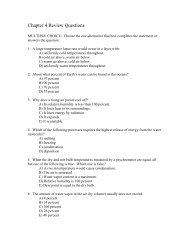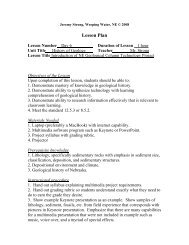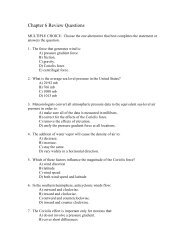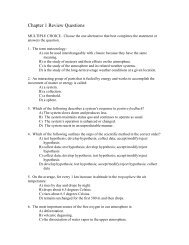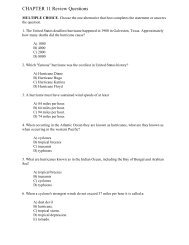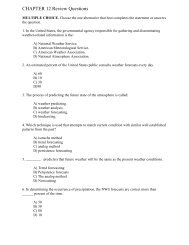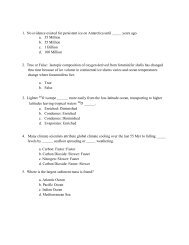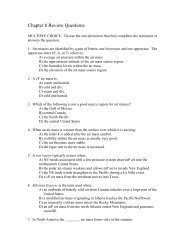Chapter 5 Review Questions - UNL | Earth and Atmospheric Sciences
Chapter 5 Review Questions - UNL | Earth and Atmospheric Sciences
Chapter 5 Review Questions - UNL | Earth and Atmospheric Sciences
- No tags were found...
You also want an ePaper? Increase the reach of your titles
YUMPU automatically turns print PDFs into web optimized ePapers that Google loves.
<strong>Chapter</strong> 5 <strong>Review</strong> <strong>Questions</strong>MULTIPLE CHOICE: Choose the one alternative that best completes the statement oranswers the question.1. Dew is most likely to form on:A) cloudy windy nights.B) clear windy nights.C) clear calm nights.D) cloudy calm nights.2. All of the following are necessary ingredients for cloud formation EXCEPT:A) warm surface air temperatures.B) rising, cooling air.C) high moisture content.D) condensation nuclei.3. Hygroscopic nuclei:A) repel water <strong>and</strong> prevent condensation.B) can allow cloud droplets to form even if the relative humidity is less than 100percent.C) are not generally found in nature.D) are not the most ideal type of condensation nuclei for encouraging dropletgrowth.4. A cloud that forms liquid droplets has a relative humidity of 100 percent with respectto the liquid droplets. If ice crystals form in this cloud, they will experience the cloudenvironment as having a relative humidity of:A) 100 percent.B) less than 100 percent.C) more than 100 percent.D) 0 percent5. Where is the driest place on <strong>Earth</strong>?A) Arica, ChileB) Riyadh, Saudi ArabiaC) Cairo, EgyptD) Canberra, Australia6. Which of these is a mid-level cloud?A) stratocumulusB) altostratusC) cumulusD) cirrusE) stratus
7. High clouds are those that form at altitudes of at least:A) 6500 ft (2000 m)B) 20,000 ft (6000 m)C) 32,800 ft (10,000 m)D) 65,617 ft (20,000 m)8. You observe a cloud at an altitude of 3000 m. This cloud name would have the prefix:A) alto.B) cirro.C) strato.D) medial.9. Where are the lenticular clouds most likely to form?A) over oceansB) along coastlinesC) to the lee of mountainsD) in desert regions10. Which association is not correct?A) fractus – clouds broken into smaller piecesB) mammatus – rounded udder-like bottomsC) uncinus – hook-shapedD) lenticular – associated with rainbows11. How are jet contrails thought to influence the surface temperatures of cities nearmajor airports?A) Decrease the daily temperature range.B) Definitely make the daily mean temperature warmer.C) Definitely make the daily mean temperature cooler.D) They have no measurable influence on surface temperature.12. Why do clouds represent a source of heat for the atmosphere?A) Cloud formation releases latent heat to the air.B) They increase the absorption of solar radiation.C) Evaporation of the droplets absorbs heat.D) They conduct heat from the <strong>Earth</strong>’s surface.E) Melting ice crystals in the cloud absorb heat.13. The important difference between liquid droplets <strong>and</strong> ice crystals in a supercooledcloud is that ice crystals:A) are more pure.B) are colder.C) grow much more rapidly.D) are smaller.E) increase the water vapor content of the cloud.
14. The water content or volume of a raindrop is approximately _______ times that of atypical cloud droplet.A) 1 millionB) 1000C) 100D) 10E) 1 billion15. Supercooled water is water which is:A) part liquid <strong>and</strong> part solid.B) a special form of ice.C) still liquid at temperatures below 0 degrees C.D) of a slightly different chemical nature than ordinary.E) produced from dry ice.16. Why are high altitude clouds always so thin?A) Winds are faster at high levels.B) Not enough particulates are present.C) Very little water vapor is present.D) Air layers are stable there.17. Most of the precipitation that falls in the middle latitudes is formed by:A) the Bergeron process.B) collision-coalescence.C) spontaneous freezing of water droplets in the absence of condensation nuclei.D) condensation of water vapor.18. Clouds, dew <strong>and</strong> frost all form because air has become saturated. This condition ofsaturation is usually caused by:A) a temperature increase.B) lack of convective mixing.C) adding water vapor.D) the air being cooled.E) an abundance of condensation nuclei.19. The growth of a hailstone usually involves everything EXCEPT:A) spontaneous freezing of large water droplets.B) being carried several times into the frozen region of the cloud by updrafts.C) ice pellets encountering supercooled water droplets.D) the development of alternating layers of clear <strong>and</strong> cloudy ice.20. The type of fog produced when cold air moves over a warm, moist surface is called:A) advection fog.B) radiation fog.C) steam fog.D) frontal fog.




